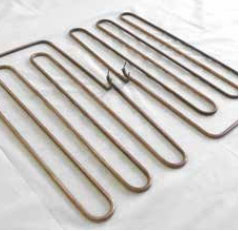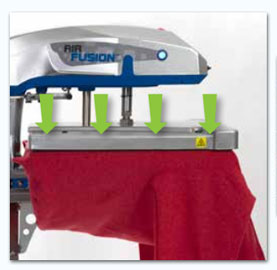The Top 3 Things to Consider Before Buying a T-Shirt Press
You are ready to start your business, and the first step is to get a t-shirt press, but where do you start?
Those $300 heat presses look enticing and you saw some good reviews.
But before you pull the trigger, here are a few items to consider.
Your heat press can make all the difference to the success of your t-shirt business if you will be applying screen printed transfers.
It is really the only investment you need to get started, so it is not the place to cut corners.
[Related Content: Starting a T-Shirt Business: How to Choose a Heat Press]
Consider these top 3 things when shopping for a t-shirt heat press.
1. Will the top platen of the heat press provide even heat?
The shape of the heating element inside the top platen of the t-shirt press is key to even heat.
Ask to see the configuration of the heating element. The coil of the heating element of the t-shirt press should be close together, and go edge-to-edge of the platen.
Why?
Where there is no heating element, there is no heat. You want a press with the heating element close together.

A wide gap in the shape of the element can create a cold spot. Your custom transfer won’t apply correctly in cold spots.
A cheap heat press machine will have wider gaps in the element as a way to cut costs down.
2. Will your t-shirt press retain heat?
If you are starting a t-shirt business using custom transfers, your average run will be 25-50 t-shirts.
You want the first shirt to apply as well as the last. The thickness of a heat press platen is directly related to its ability to retain heat.
To best retain heat, your platen should be ¾” thick. Presses that are less than that, may not get the heat to your application throughout your run.

You don’t want to have to stop in the middle of a t-shirt printing run to wait for your t-shirt press to get back up to the application temperature.
You also don’t want to run into application issues in the middle of a run because of a drop in temperature.
Not only will it slow you down, which can be frustrating in itself, you can possibly end up with ruined apparel, which is even more frustrating.
It will even hurt your profit margin.
[Related Content: How to Win the Temperature War with your Heat Press]
3. Does the t-shirt press provide even pressure?
The three variables for a successful application are time, temperature and pressure.
No matter what press you buy, you can control your application time, even if it requires a standalone timer, which you may need with a cheaper press.
The first two variables to consider on our list above dictate your temperature.
However, pressure, although harder to measure on a manual press, is just as critical.
The upper platen needs to meet the lower platen equally and without pinch points.
Look for a press with over-the-center pressure adjustments that will ensure even, edge-to-edge pressure during your application.

Just like uneven temperature, uneven pressure can result in some spots of the transfer being applied well, while other locations being under or over applied.
Another area of concern with uneven pressure comes from a warped platen. A warped platen will always cause application issues because of uneven pressure.
During the manufacturing of a good t-shirt press, there is a process used to prevent the platen from warping after extended usage. Heat presses that are not created with this process will see warped platens over time, making the press useless.
Conclusion
Since your heat press is your only investment for your T-shirt business, do your research before you buy.
[Related Content: T-Shirt Business Starter Kit]
Many times, a cheap t-shirt press is not made with a t-shirt business in mind.
They may work well for crafts, which will have a much less intended volume, or with other materials, like heat transfer vinyl (htv), which have more flexibility for application error.
But a cheaper heat press will not work well with larger quantity runs or with screen printed transfers.
If you get larger quantity t-shirt orders, you will want to use screen printed transfers.
Even if you are only intending on cutting and using heat transfer vinyl, make sure your t-shirt press is ready to handle multiple materials of transfers. This includes screen printed transfers.
[Related Content: 4 Reasons When You Should Switch from Vinyl (htv) to Screen Printed Transfers]
Buying a cheap press will back yourself into a corner in the long run if your press can’t handle materials you’ll need down the road.
All heat presses are not created equal.
In the end, you’ll end up spending more money from having to buy multiple presses.
So make sure the t-shirt press that you choose to buy has:
- a heating element that covers the entire upper platen for even heat
- a thick platen that will retain the heat for an entire printing run of shirts
- a design that ensures even pressure over the entire printing surface
Save yourself the frustrations and headaches. Do your due diligence on researching ahead of time and set yourself up for success from the start.
Download our complete checklist before you make a decision.

